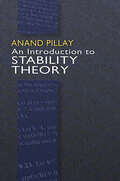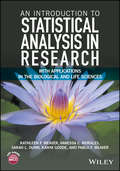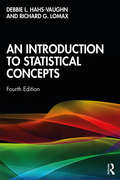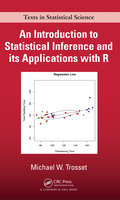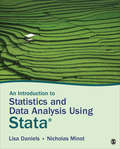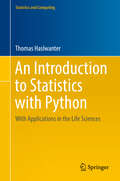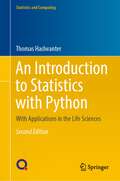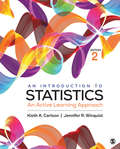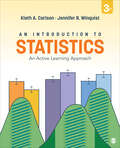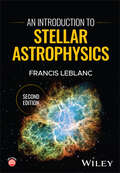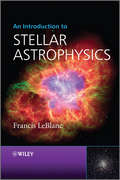- Table View
- List View
An Introduction to Sports Coaching: Connecting Theory to Practice
by Kieran Kingston Robyn L. JonesAn Introduction to Sports Coaching provides students with an accessible and engaging guide to the scientific, social scientific, medical and pedagogical theory that underlies the practice of quality sports coaching. Now in a fully updated and revised second edition, it introduces students to the complex, messy, multi-faceted nature of coaching, and explores the full range of 'knowledges' which inform all successful coaching practice. Written by a team of leading international sports coaching academics and practitioners, as well as sport scientists and social scientists, the book provides a concise guide to every key theme in sports coaching, including: Reflective practice Pedagogy Skill acquisition Psychology Biomechanics Physiology Sport medicine and injury Performance analysis Sociology History Philosophy Sport development Each chapter makes a clear link between theory and practice, and includes discussion of real-life coaching scenarios and insights from practising international and club coaches. The book includes clear definitions of important themes and concepts, as well as seminar and review questions in each chapter designed to confirm understanding and encourage further enquiry. No other introductory textbook explains the importance of an holistic approach to sports coaching practice. This is an essential companion to any sports coaching course.
An Introduction to Stability Theory (Dover Books on Mathematics)
by Anand PillayThis introductory treatment covers the basic concepts and machinery of stability theory. Lemmas, corollaries, proofs, and notes assist readers in working through and understanding the material and applications. Full of examples, theorems, propositions, and problems, it is suitable for graduate students in logic and mathematics, professional mathematicians, and computer scientists. Chapter 1 introduces the notions of definable type, heir, and coheir. A discussion of stability and order follows, along with definitions of forking that follow the approach of Lascar and Poizat, plus a consideration of forking and the definability of types. Subsequent chapters examine superstability, dividing and ranks, the relation between types and sets of indiscernibles, and further properties of stable theories. The text concludes with proofs of the theorems of Morley and Baldwin-Lachlan and an extension of dimension theory that incorporates orthogonality of types in addition to regular types.
An Introduction to Statistical Analysis in Research: With Applications in the Biological and Life Sciences
by Kanya Godde Kathleen F. Weaver Pablo F. Weaver Sarah L. Dunn Vanessa C. MoralesProvides well-organized coverage of statistical analysis and applications in biology, kinesiology, and physical anthropology with comprehensive insights into the techniques and interpretations of R, SPSS®, Excel®, and Numbers® output An Introduction to Statistical Analysis in Research: With Applications in the Biological and Life Sciences develops a conceptual foundation in statistical analysis while providing readers with opportunities to practice these skills via research-based data sets in biology, kinesiology, and physical anthropology. Readers are provided with a detailed introduction and orientation to statistical analysis as well as practical examples to ensure a thorough understanding of the concepts and methodology. In addition, the book addresses not just the statistical concepts researchers should be familiar with, but also demonstrates their relevance to real-world research questions and how to perform them using easily available software packages including R, SPSS®, Excel®, and Numbers®. Specific emphasis is on the practical application of statistics in the biological and life sciences, while enhancing reader skills in identifying the research questions and testable hypotheses, determining the appropriate experimental methodology and statistical analyses, processing data, and reporting the research outcomes. In addition, this book: • Aims to develop readers’ skills including how to report research outcomes, determine the appropriate experimental methodology and statistical analysis, and identify the needed research questions and testable hypotheses • Includes pedagogical elements throughout that enhance the overall learning experience including case studies and tutorials, all in an effort to gain full comprehension of designing an experiment, considering biases and uncontrolled variables, analyzing data, and applying the appropriate statistical application with valid justification • Fills the gap between theoretically driven, mathematically heavy texts and introductory, step-by-step type books while preparing readers with the programming skills needed to carry out basic statistical tests, build support figures, and interpret the results • Provides a companion website that features related R, SPSS, Excel, and Numbers data sets, sample PowerPoint® lecture slides, end of the chapter review questions, software video tutorials that highlight basic statistical concepts, and a student workbook and instructor manual An Introduction to Statistical Analysis in Research: With Applications in the Biological and Life Sciences is an ideal textbook for upper-undergraduate and graduate-level courses in research methods, biostatistics, statistics, biology, kinesiology, sports science and medicine, health and physical education, medicine, and nutrition. The book is also appropriate as a reference for researchers and professionals in the fields of anthropology, sports research, sports science, and physical education. KATHLEEN F. WEAVER, PhD, is Associate Dean of Learning, Innovation, and Teaching and Professor in the Department of Biology at the University of La Verne. The author of numerous journal articles, she received her PhD in Ecology and Evolutionary Biology from the University of Colorado. VANESSA C. MORALES, BS, is Assistant Director of the Academic Success Center at the University of La Verne. SARAH L. DUNN, PhD, is Associate Professor in the Department of Kinesiology at the University of La Verne and is Director of Research and Sponsored Programs. She has authored numerous journal articles and received her PhD in Health and Exercise Science from the University of New South Wales. KANYA GODDE, PhD, is Assistant Professor in the Department of Anthropology and is Director/Chair of Institutional Review Board at the University of La Verne. The author of numerous j
An Introduction to Statistical Computing: A Simulation-based Approach (Wiley Series in Computational Statistics)
by Jochen VossA comprehensive introduction to sampling-based methods in statistical computing The use of computers in mathematics and statistics has opened up a wide range of techniques for studying otherwise intractable problems. Sampling-based simulation techniques are now an invaluable tool for exploring statistical models. This book gives a comprehensive introduction to the exciting area of sampling-based methods. An Introduction to Statistical Computing introduces the classical topics of random number generation and Monte Carlo methods. It also includes some advanced methods such as the reversible jump Markov chain Monte Carlo algorithm and modern methods such as approximate Bayesian computation and multilevel Monte Carlo techniques An Introduction to Statistical Computing: Fully covers the traditional topics of statistical computing. Discusses both practical aspects and the theoretical background. Includes a chapter about continuous-time models. Illustrates all methods using examples and exercises. Provides answers to the exercises (using the statistical computing environment R); the corresponding source code is available online. Includes an introduction to programming in R. This book is mostly self-contained; the only prerequisites are basic knowledge of probability up to the law of large numbers. Careful presentation and examples make this book accessible to a wide range of students and suitable for self-study or as the basis of a taught course
An Introduction to Statistical Concepts: Third Edition
by Debbie L. Hahs-Vaughn Richard G. LomaxThis comprehensive, flexible text is used in both one- and two-semester courses to review introductory through intermediate statistics. Instructors select the topics that are most appropriate for their course. Its conceptual approach helps students more easily understand the concepts and interpret SPSS and research results. Key concepts are simply stated and occasionally reintroduced and related to one another for reinforcement. Numerous examples demonstrate their relevance. This edition features more explanation to increase understanding of the concepts. Only crucial equations are included.In addition to updating throughout, the new edition features: New co-author, Debbie L. Hahs-Vaughn, the 2007 recipient of the University of Central Florida's College of Education Excellence in Graduate Teaching Award. A new chapter on logistic regression models for today's more complex methodologies. More on computing confidence intervals and conducting power analyses using G*Power. Many more SPSS screenshots to assist with understanding how to navigate SPSS and annotated SPSS output to assist in the interpretation of results. Extended sections on how to write-up statistical results in APA format. New learning tools including chapter-opening vignettes, outlines, and a list of key concepts, many more examples, tables, and figures, boxes, and chapter summaries. More tables of assumptions and the effects of their violation including how to test them in SPSS. 33% new conceptual, computational, and all new interpretative problems. A website that features PowerPoint slides, answers to the even-numbered problems, and test items for instructors, and for students the chapter outlines, key concepts, and datasets that can be used in SPSS and other packages, and more. Each chapter begins with an outline, a list of key concepts, and a vignette related to those concepts. Realistic examples from education and the behavioral sciences illustrate those concepts. Each example examines the procedures and assumptions and provides instructions for how to run SPSS, including annotated output, and tips to develop an APA style write-up. Useful tables of assumptions and the effects of their violation are included, along with how to test assumptions in SPSS. 'Stop and Think' boxes provide helpful tips for better understanding the concepts. Each chapter includes computational, conceptual, and interpretive problems. The data sets used in the examples and problems are provided on the web. Answers to the odd-numbered problems are given in the book. The first five chapters review descriptive statistics including ways of representing data graphically, statistical measures, the normal distribution, and probability and sampling. The remainder of the text covers inferential statistics involving means, proportions, variances, and correlations, basic and advanced analysis of variance and regression models. Topics not dealt with in other texts such as robust methods, multiple comparison and nonparametric procedures, and advanced ANOVA and multiple and logistic regression models are also reviewed.Intended for one- or two-semester courses in statistics taught in education and/or the behavioral sciences at the graduate and/or advanced undergraduate level, knowledge of statistics is not a prerequisite. A rudimentary knowledge of algebra is required.
An Introduction to Statistical Concepts: Third Edition
by Richard G. Lomax Debbie L. Hahs-VaughnThe new edition of An Introduction to Statistical Concepts, is designed to help students really understand statistical concepts, the situations in which they can be used, and how to apply them to data. Hahs-Vaughn and Lomax discuss the most popular, along with many of the lesser-known, procedures and models, whilst also exploring nonparametric procedures used when standard assumptions are violated. They provide in-depth coverage of testing assumptions and highlight several online tools for computing statistics (e.g., effect sizes and their confidence intervals and power). This comprehensive, flexible and accessible text includes a new chapter on mediation and moderation; expanded coverage of effect sizes; discussions of sensitivity, specificity, false positive, and false negative, along with using the receiver operator characteristic (ROC) curve. This book, noted for its crystal-clear explanations, and its inclusion of only the most crucial equations, is an invaluable resource for students undertaking a course in statistics in any number of social science and behavioral disciplines—from education, business, communication, exercise science, psychology, sociology and more.
An Introduction to Statistical Data Science: Theory and Models
by Giorgio PicciThis graduate textbook on the statistical approach to data science describes the basic ideas, scientific principles and common techniques for the extraction of mathematical models from observed data. Aimed at young scientists, and motivated by their scientific prospects, it provides first principle derivations of various algorithms and procedures, thereby supplying a solid background for their future specialization to diverse fields and applications. The beginning of the book presents the basics of statistical science, with an exposition on linear models. This is followed by an analysis of some numerical aspects and various regularization techniques, including LASSO, which are particularly important for large scale problems. Decision problems are studied both from the classical hypothesis testing perspective and, particularly, from a modern support-vector perspective, in the linear and non-linear context alike. Underlying the book is the Bayesian approach and the Bayesian interpretation of various algorithms and procedures. This is the key to principal components analysis and canonical correlation analysis, which are explained in detail. Following a chapter on nonlinear inference, including material on neural networks, the book concludes with a discussion on time series analysis and estimating their dynamic models. Featuring examples and exercises partially motivated by engineering applications, this book is intended for graduate students in applied mathematics and engineering with a general background in probability and linear algebra.
An Introduction to Statistical Genetic Data Analysis (The\mit Press Ser.)
by Melinda C. Mills Nicola Barban Felix C. TropfA comprehensive introduction to modern applied statistical genetic data analysis, accessible to those without a background in molecular biology or genetics.Human genetic research is now relevant beyond biology, epidemiology, and the medical sciences, with applications in such fields as psychology, psychiatry, statistics, demography, sociology, and economics. With advances in computing power, the availability of data, and new techniques, it is now possible to integrate large-scale molecular genetic information into research across a broad range of topics. This book offers the first comprehensive introduction to modern applied statistical genetic data analysis that covers theory, data preparation, and analysis of molecular genetic data, with hands-on computer exercises. It is accessible to students and researchers in any empirically oriented medical, biological, or social science discipline; a background in molecular biology or genetics is not required.The book first provides foundations for statistical genetic data analysis, including a survey of fundamental concepts, primers on statistics and human evolution, and an introduction to polygenic scores. It then covers the practicalities of working with genetic data, discussing such topics as analytical challenges and data management. Finally, the book presents applications and advanced topics, including polygenic score and gene-environment interaction applications, Mendelian Randomization and instrumental variables, and ethical issues. The software and data used in the book are freely available and can be found on the book's website.
An Introduction to Statistical Inference and Its Applications with R (Chapman & Hall/CRC Texts in Statistical Science)
by Michael W. TrossetEmphasizing concepts rather than recipes, An Introduction to Statistical Inference and Its Applications with R provides a clear exposition of the methods of statistical inference for students who are comfortable with mathematical notation. Numerous examples, case studies, and exercises are included. R is used to simplify computation, create figures
An Introduction to Statistical Learning: with Applications in R (Springer Texts in Statistics #103)
by Trevor Hastie Gareth James Robert Tibshirani Daniela WittenAn Introduction to Statistical Learning provides an accessible overview of the field of statistical learning, an essential toolset for making sense of the vast and complex data sets that have emerged in fields ranging from biology to finance to marketing to astrophysics in the past twenty years. This book presents some of the most important modeling and prediction techniques, along with relevant applications. Topics include linear regression, classification, resampling methods, shrinkage approaches, tree-based methods, support vector machines, clustering, and more. Color graphics and real-world examples are used to illustrate the methods presented. Since the goal of this textbook is to facilitate the use of these statistical learning techniques by practitioners in science, industry, and other fields, each chapter contains a tutorial on implementing the analyses and methods presented in R, an extremely popular open source statistical software platform. Two of the authors co-wrote The Elements of Statistical Learning (Hastie, Tibshirani and Friedman, 2nd edition 2009), a popular reference book for statistics and machine learning researchers. An Introduction to Statistical Learning covers many of the same topics, but at a level accessible to a much broader audience. This book is targeted at statisticians and non-statisticians alike who wish to use cutting-edge statistical learning techniques to analyze their data. The text assumes only a previous course in linear regression and no knowledge of matrix algebra.
An Introduction to Statistical Problem Solving in Geography
by J. Chapman McGrew Arthur J. Lembo Charles B. MonroeGeography students need a solid introduction to the variety of ways in which statistical procedures are used to explore and solve realistic geographic problems. This book is designed to provide a comprehensive and understandable introduction to statistical methods in a practical, problem solving framework. Students who use this text in a spatial analysis or statistical methods course should acquire a well-grounded foundation and feel comfortable in applying statistical techniques in research problems or situations that they might encounter in their subsequent geographic education and careers. This book is targeted for undergraduate geography majors and beginning graduate students who do not have a strong background in statistical approaches to geographic problem solving.
An Introduction to Statistical Thermodynamics (Dover Books On Physics Series)
by Terrell L. HillAlthough written on an introductory level, this wide-ranging text provides extensive coverage of topics of current interest in equilibrium statistical mechanics. Indeed, certain traditional topics are given somewhat condensed treatment to allow room for a survey of more recent advances.The book is divided into four major sections. Part I deals with the principles of quantum statistical mechanics and includes discussions of energy levels, states and eigenfunctions, degeneracy and other topics. Part II examines systems composed of independent molecules or of other independent subsystems. Topics range from ideal monatomic gas and monatomic crystals to polyatomic gas and configuration of polymer molecules and rubber elasticity. An examination of systems of interacting molecules comprises the nine chapters in Part Ill, reviewing such subjects as lattice statistics, imperfect gases and dilute liquid solutions. Part IV covers quantum statistics and includes sections on Fermi-Dirac and Bose-Einstein statistics, photon gas and free-volume theories of quantum liquids.Each chapter includes problems varying in difficulty — ranging from simple numerical exercises to small-scale "research" propositions. In addition, supplementary reading lists for each chapter invite students to pursue the subject at a more advanced level. Readers are assumed to have studied thermodynamics, calculus, elementary differential equations and elementary quantum mechanics.Because of the flexibility of the chapter arrangements, this book especially lends itself to use in a one-or two-semester graduate course in chemistry, a one-semester senior or graduate course in physics or an introductory course in statistical mechanics.
An Introduction to Statistics and Data Analysis Using Stata®: From Research Design to Final Report
by Lisa Daniels Nicholas W. MinotAn Introduction to Statistics and Data Analysis Using Stata® by Lisa Daniels and Nicholas Minot provides a step-by-step introduction for statistics, data analysis, or research methods classes with Stata. Concise descriptions emphasize the concepts behind statistics for students rather than the derivations of the formulas. With real-world examples from a variety of disciplines and extensive detail on the commands in Stata, this text provides an integrated approach to research design, statistical analysis, and report writing for social science students.
An Introduction to Statistics and Data Analysis Using Stata®: From Research Design to Final Report
by Lisa Daniels Nicholas W. MinotAn Introduction to Statistics and Data Analysis Using Stata® by Lisa Daniels and Nicholas Minot provides a step-by-step introduction for statistics, data analysis, or research methods classes with Stata. Concise descriptions emphasize the concepts behind statistics for students rather than the derivations of the formulas. With real-world examples from a variety of disciplines and extensive detail on the commands in Stata, this text provides an integrated approach to research design, statistical analysis, and report writing for social science students.
An Introduction to Statistics and Data Analysis Using Stata®: From Research Design to Final Report
by Lisa Daniels Nicholas W. MinotAn Introduction to Statistics and Data Analysis Using Stata®: From Research Design to Final Report, Second Edition provides an integrated approach to research methods, statistics and data analysis, and interpretation of results in Stata. Drawing on their combined 25 years of experience teaching statistics and research methods, authors Lisa Daniels and Nicholas Minot frame data analysis within the research process—identifying gaps in the literature, examining the theory, developing research questions, designing a questionnaire or using secondary data, analyzing the data, and writing a research paper—so readers better understand the context of data analysis. Throughout, the text focuses on documenting and communicating results so students can produce a finished report or article by the end of their courses. The Second Edition has been thoroughly updated with all new articles and data—including coverage of ChatGPT, COVID-19 policies, and SAT scores—to demonstrate the relevance of data analysis for students. A new chapter on advanced methods in regression analysis allows instructors to better feature these important techniques. Stata code has been updated to the latest version, and new exercises throughout offer more chances for practice.
An Introduction to Statistics and Data Analysis Using Stata®: From Research Design to Final Report
by Lisa Daniels Nicholas W. MinotAn Introduction to Statistics and Data Analysis Using Stata®: From Research Design to Final Report, Second Edition provides an integrated approach to research methods, statistics and data analysis, and interpretation of results in Stata. Drawing on their combined 25 years of experience teaching statistics and research methods, authors Lisa Daniels and Nicholas Minot frame data analysis within the research process—identifying gaps in the literature, examining the theory, developing research questions, designing a questionnaire or using secondary data, analyzing the data, and writing a research paper—so readers better understand the context of data analysis. Throughout, the text focuses on documenting and communicating results so students can produce a finished report or article by the end of their courses. The Second Edition has been thoroughly updated with all new articles and data—including coverage of ChatGPT, COVID-19 policies, and SAT scores—to demonstrate the relevance of data analysis for students. A new chapter on advanced methods in regression analysis allows instructors to better feature these important techniques. Stata code has been updated to the latest version, and new exercises throughout offer more chances for practice.
An Introduction to Statistics with Python: With Applications in the Life Sciences (Statistics and Computing)
by Thomas HaslwanterThis textbook provides anintroduction to the free software Python and its use for statistical dataanalysis. It covers common statistical tests for continuous, discrete andcategorical data, as well as linear regression analysis and topics from survivalanalysis and Bayesian statistics. Working code and data for Python solutionsfor each test, together with easy-to-follow Python examples, can be reproducedby the reader and reinforce their immediate understanding of the topic. Withrecent advances in the Python ecosystem, Python has become a popular languagefor scientific computing, offering a powerful environment for statistical dataanalysis and an interesting alternative to R. The book is intended for masterand PhD students, mainly from the life and medical sciences, with a basicknowledge of statistics. As it also provides some statistics background, thebook can be used by anyone who wants to perform a statistical dataanalysis.
An Introduction to Statistics with Python: With Applications in the Life Sciences (Statistics and Computing)
by Thomas HaslwanterNow in its second edition, this textbook provides an introduction to Python and its use for statistical data analysis. It covers common statistical tests for continuous, discrete and categorical data, as well as linear regression analysis and topics from survival analysis and Bayesian statistics.For this new edition, the introductory chapters on Python, data input and visualization have been reworked and updated. The chapter on experimental design has been expanded, and programs for the determination of confidence intervals commonly used in quality control have been introduced. The book also features a new chapter on finding patterns in data, including time series. A new appendix describes useful programming tools, such as testing tools, code repositories, and GUIs.The provided working code for Python solutions, together with easy-to-follow examples, will reinforce the reader’s immediate understanding of the topic. Accompanying data sets and Python programs are also available online. With recent advances in the Python ecosystem, Python has become a popular language for scientific computing, offering a powerful environment for statistical data analysis.With examples drawn mainly from the life and medical sciences, this book is intended primarily for masters and PhD students. As it provides the required statistics background, the book can also be used by anyone who wants to perform a statistical data analysis.
An Introduction to Statistics: An Active Learning Approach
by Kieth A. Carlson Jennifer R. WinquistAn Introduction to Statistics: An Active Learning Approach, Second Edition by Kieth A. Carlson and Jennifer R. Winquist takes a unique, active approach to teaching and learning introductory statistics that allows students to discover and correct their misunderstandings as chapters progress rather than at their conclusion. Empirically-developed, self-correcting activities reinforce and expand on fundamental concepts, targeting and holding students’ attention. Based on contemporary memory research, this learner-centered approach leads to better long-term retention through active engagement while generating explanations. Along with carefully placed reading questions, this edition includes learning objectives, realistic research scenarios, practice problems, self-test questions, problem sets, and practice tests to help students become more confident in their ability to perform statistics.
An Introduction to Statistics: An Active Learning Approach
by Kieth A. Carlson Jennifer R. WinquistAn Introduction to Statistics: An Active Learning Approach, Second Edition by Kieth A. Carlson and Jennifer R. Winquist takes a unique, active approach to teaching and learning introductory statistics that allows students to discover and correct their misunderstandings as chapters progress rather than at their conclusion. Empirically-developed, self-correcting activities reinforce and expand on fundamental concepts, targeting and holding students’ attention. Based on contemporary memory research, this learner-centered approach leads to better long-term retention through active engagement while generating explanations. Along with carefully placed reading questions, this edition includes learning objectives, realistic research scenarios, practice problems, self-test questions, problem sets, and practice tests to help students become more confident in their ability to perform statistics.
An Introduction to Statistics: An Active Learning Approach
by Jennifer R. Winquist Kieth Alton CarlsonThis updated and reorganized Third Edition of this textbook takes a workbook-style approach that encourages an active approach to learning statistics. Carefully placed reading questions throughout each chapter allow students to apply their knowledge right away, while in-depth activities based on current behavioral science scenarios, each with problem sets and quiz questions, give students the opportunity to assess their understanding of concepts while reading detailed explanations of more complex statistical concepts. Additional practice problems further solidify student learning. Most activities are self-correcting, so if a concept is misunderstood, this misunderstanding is corrected early in the learning process. After working through each chapter, students are far more likely to understand the material than when they only read the material.
An Introduction to Statistics: An Active Learning Approach
by Jennifer R. Winquist Kieth Alton CarlsonThis updated and reorganized Third Edition of this textbook takes a workbook-style approach that encourages an active approach to learning statistics. Carefully placed reading questions throughout each chapter allow students to apply their knowledge right away, while in-depth activities based on current behavioral science scenarios, each with problem sets and quiz questions, give students the opportunity to assess their understanding of concepts while reading detailed explanations of more complex statistical concepts. Additional practice problems further solidify student learning. Most activities are self-correcting, so if a concept is misunderstood, this misunderstanding is corrected early in the learning process. After working through each chapter, students are far more likely to understand the material than when they only read the material.
An Introduction to Stellar Astrophysics
by Francis LeBlancAccessible and student-friendly textbook on the astrophysics of stars, now with new observational data and physical concepts An Introduction to Stellar Astrophysics is a concise textbook containing core content on and detailed examples of stellar physics and stellar astronomy. This new edition is revised and expanded and contains updated and new material on nearest and brightest stars, binary stars, Wolf Rayet stars and blue horizontal-branch stars, stellar evolution modeling and gravitational waves. The book is divided in seven chapters: basic concepts, stellar formation, radiative transfer in stars, stellar atmospheres, stellar interiors, nucleosynthesis and stellar evolution, and chemically peculiar stars and diffusion. Student-friendly features include detailed examples, exercises with selected solutions, brief recalls of the most important physical concepts, chapter summaries, and optional and advanced sections that can be skipped on first reading. A large number of graphs and figures are included to better explain the concepts covered. Only essential astronomical data are given, and the amount of observational results shown is deliberately limited in scope. An Introduction to Stellar Astrophysics includes information on: The electromagnetic spectrum, blackbody radiation, luminosity, effective temperature, the Boltzmann and Saha equations, and the Hertzsprung-Russell diagramHydrostatic equilibrium, the Virial theorem, the Jeans criteria, free-fall times, and pre-main-sequence evolutionRadiative opacities, specific intensity and radiative moments, local thermodynamic equilibrium, radiative transfer and stellar atmospheresEnergy transport in stars, polytropic models, stellar evolution, advanced nuclear burning, stellar remnants, and novae and supernovaeDiffusion theory, radiative accelerations, and other transport processesNew to this edition: sections on nearest and brightest stars, binary stars, the Eddington limit and stellar evolution modeling as well as several new special topics and additional exercises Delivering intermediate knowledge on stars in a concise format, An Introduction to Stellar Astrophysics is an excellent textbook on the subject for advanced undergraduate and graduate students studying physics and astrophysics.
An Introduction to Stellar Astrophysics
by Francis LeblancAn Introduction to Stellar Astrophysics aspires to provide the reader with an intermediate knowledge on stars whilst focusing mostly on the explanation of the functioning of stars by using basic physical concepts and observational results.The book is divided into seven chapters, featuring both core and optional content:Basic conceptsStellar FormationRadiative Transfer in StarsStellar AtmospheresStellar InteriorsNucleosynthesis and Stellar Evolution andChemically Peculiar Stars and Diffusion.Student-friendly features include:Detailed examples to help the reader better grasp the most important conceptsA list of exercises is given at the end of each chapter and answers to a selection of these are presented.Brief recalls of the most important physical concepts needed to properly understand stars.A summary for each chapterOptional and advanced sections are included which may be skipped without interfering with the flow of the core content.This book is designed to cover the most important aspects of stellar astrophysics inside a one semester (or half-year) course and as such is relevant for advanced undergraduate students following a first course on stellar astrophysics, in physics or astronomy programs. It will also serve as a basic reference for a full-year course as well as for researchers working in related fields.
An Introduction to Stochastic Processes in Physics
by Don S. LemonsThis book provides an accessible introduction to stochastic processes in physics and describes the basic mathematical tools of the trade: probability, random walks, and Wiener and Ornstein-Uhlenbeck processes. It includes end-of-chapter problems and emphasizes applications.An Introduction to Stochastic Processes in Physics builds directly upon early-twentieth-century explanations of the "peculiar character in the motions of the particles of pollen in water" as described, in the early nineteenth century, by the biologist Robert Brown. Lemons has adopted Paul Langevin's 1908 approach of applying Newton's second law to a "Brownian particle on which the total force included a random component" to explain Brownian motion. This method builds on Newtonian dynamics and provides an accessible explanation to anyone approaching the subject for the first time. Students will find this book a useful aid to learning the unfamiliar mathematical aspects of stochastic processes while applying them to physical processes that he or she has already encountered.

